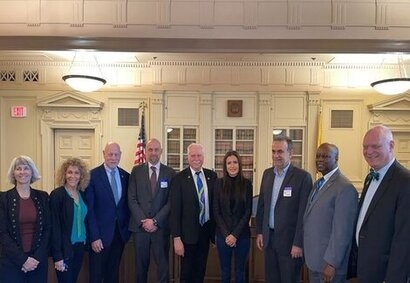
The Assembly Special Committee on Infrastructure and Natural Resources was presided by chairman Assemblyman Robert Karabinchak. The list of participants who provided testimony to the Committee that took place on Thursday, March 17, 2022, included Philipp Stratmann, President and CEO of Ocean Power Technologies, Marcus Lehmann, Founder and CEO of CalWave Power Technologies Inc., Professor Muhammad R. Hajj, Chair of the Department of Civil, Environmental and Ocean Engineering and Director of the Davidson Laboratory at New Jersey’s Stevens Institute of Technology and Patty Cronheim, Director at New Jersey League of Conservation Campaigns.
“This session is extremely important for our future” said Assemblyman Karabinchak, opening the session. “On a personal side, energy is going to change in the future. Wind turbines and our solar farms are the start for clean energy in New Jersey, however, there are also other sources for renewable energy, and we are going to speak about one of them today – which is wave energy. This is the future, and today we have the opportunity to speak about our future needs and the sources of energy that produce clean energy and will help us get away from fossil fuels in the future.”
The next speaker was Professor Muhammad R. Hajj, who explained that the blue economy is a very large economy in the world at 1.5 trillion dollars and that in New Jersey, most of the population - around 7.1 million lives in coastal regions.
“To give you an idea, in wind industry, when you have one metre square, 9 metres per second, that gives you 470 watts per square metre” said Professor Hajj. “In comparison, when you have one metre of wave height it will give you ten times as much power, which is 4900 watts per metre. This is significant because one metre of wave, even if I take an efficiency of 25 percent, could power a household for a whole year, and New Jersey actually has 10,000 watts per metre right on the shore. Wind and solar farms take a lot of space… they need up to 50 times the space that is required for coal and 100 times the space that is required for fossil fuels, and this has been an impediment, because land can be used for agriculture and for other things and you don’t want to use all the land for solar and wind farms. Wave power could address this problem. We are not looking at wave power for just powering the grid, wave power can be used to power the blue economy…We could use wave energy to power remote islands and remote communities – it takes a lot of power to transport fossil fuels and power, we could do this directly with wave power… Wave power could be used for building more resilient coastal communities and use wave power when we do not have power during hurricanes … We could also use it for desalination, can you imagine having water and energy at the same place and the same time? You could do a lot with that technology...”
According to the US Energy Information Administration, wave energy can provide around 66 percent of all US Energy needs, explained Eco Wave Power CEO Inna Braverman, adding that the advantages of Eco Wave Power’s innovative technology are that the Company’s technology is cost-efficient, reliable, insurable, environmentally friendly and can safely connect to the grid.
Eco Wave Power is very interested in harnessing wave energy in New Jersey because of its very significant wave energy potential and in light of New Jersey’s very ambitious Energy Master Plan.
“New Jersey has been a leader of energy innovation since the days of Thomas Edison” said Ms Braverman. “If electricity from the waves will replace the Logan Township and Chambers coal plants, which are the last remaining coal plants in the State of New Jersey, the reductions in CO2 emissions will have a similar effect as taking about 800,000 passenger vehicles off the road for one year.”
For additional information:

